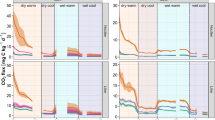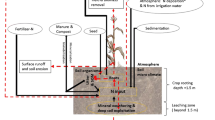Abstract
The fate of the added N on a sandy loam soil was determined in an improved fallow - maize sequence field experiment in Zimbabwe. Pre-season mineral N was determined in 20 cm sections to 120 cm depth by soil auguring in seven land use systems. Thereafter, sequential soil auguring was done at two-week intervals in plots that previously had 2-year fallows of Acacia angustissima, Sesbania sesban and unfertilized maize to determine mineral N dynamics. Using the static chamber technique, N2O fluxes were also determined in the same plots. Pre-season NH4-N concentrations were >12 kg N ha−1 in the 0–20 cm layer for treatments that had a pronounced litter layer. NO3-N concentrations below 60 cm depth were <3 kg N ha−1 layer−1 for Sesban, Acacia, Cajanus cajan and natural woodland compared with >10 kg N ha−1 layer−1 in the control plots where maize had been cultivated each year. There was a flush of NO3-N in the Sesbania and Acacia plots with the first rains. Topsoil NO3-N had increased to >29 kg N ha−1 by the time of establishing the maize crop. This increase in NO3-N in the topsoil was not sustained as concentrations decreased rapidly within three weeks of maize planting, to amounts of 8.6 kg N ha−1 and 11.2 kg N ha−1 for the Sesbania and Acacia plots, respectively. Total NO3-N leaching losses from the 0–40 cm layer ranged from 29–40 kg ha−1 for Sesbania and Acacia plots within two weeks when 104 mm rainfall was received to an already fully recharged soil profile. Nitrate then accumulated below the 40 cm depth during early season when the maize had not developed a sufficient root length density to effectively capture nutrients. At one week after planting maize, N2O fluxes of 12.3 g N2O-N ha−1 day−1 from Sesbania plots were about twice as high as those from Acacia, and about seven times the 1.6 g N2O-N ha−1 day−1 from maize monoculture. This was at the time when mineral N was at its peak in the topsoil. The unfertilized maize showed consistently low N2O emissions, which never exceeded 2 g N2O-N ha−1 day−1 for all the eight sampling dates. The decrease of mineral N concentration in the topsoil resulted in reduced N2O fluxes, despite very high soil moisture conditions. Total N2O-N emissions were greatest for Sesbania plots with 0.3 kg ha−1 lost in 56 days. We conclude that, under high rainfall conditions, there is an inherent problem in managing mineral N originating from mineralization of organic materials as it accumulates at the onset of rains, and is susceptible to leaching before the crop root system develops. We did not quantify nitric oxide and N2 gas emissions, but it is unlikely that total gaseous N losses would be significant and contribute to poor N recovery that has been widely reported.
Similar content being viewed by others
References
Addiscott T M 2000 Tillage, mineralization and leaching. Soil Tillage Res. 53, 163–165.
Baggs E M, Rees R M, Smith K A and Vinten A J A 2000 Nitrous oxide emission from soils after incorporating crop residues. Soil Use Manag. 16, 82–87.
Beare M H, Cabrera M L, Hendrix P F and Coleman D C 1994 Aggregate protected and unprotected organic matter pools in conventional and no-tillage soils. Soil Sci. Soc. Am. J. 58, 787–795.
Birch H F 1964 Mineralisation of plant nitrogen following alternative wet and dry conditions. Plant Soil 20, 43–49.
Bouwman A F 1996 Direct emission of nitrous oxide from agricultural soils. Nutr. Cyc. Agroecosys. 46, 53–70.
Cameron K C and Haynes R J 1986 Retention and movement of nitrogen in soils. In Mineral Nitrogen in the Plant-Soil System. Ed. T T Kozlowski. pp. 185–211. Academic Press, Florida, USA.
Chang C, Cho C M and Janzen H H 1998 Nitrous oxide emissions from long-term manured soils. Soil Sci. Soc. Am. J. 62, 677–682.
Chikowo R, Mapfumo P, Nyamugafata P and Giller K E 2004 Woody legume fallow productivity, biological N2-fixation and residual benefits to two successive maize crops in Zimbabwe. Plant Soil (in press).
Christensen S 1983 Nitrous oxide emission from a soil under permanent grass: seasonal and diurnal fluctuations as influenced by manuring and fertilization. Soil Biol. Biochem. 15, 531–536.
Delgado J A, Mosier A R, Follett R H, Westfall D, Klemedtsson L K and Vermeulen J 1996 Effect of N management on N2O and CH4 fluxes and N recovery in an irrigated mountain meadow. Nutr. Cycl. Agroecosyst. 46, 127–134.
Dobbie K E, McTaggart I P and Smith K A 1999 Nitrous oxide emissions from intensive agricultural systems: Variations between crops and seasons, key driving variables, and mean emissions factors. J. Geophysic. Res. Atmos. 104, 26891–26899.
Elliot T E 1986 Aggregate structure and carbon, nitrogen and phosphorus in native and cultivated soils. Soil Sci. Soc. Am. J. 50, 627–633.
Firestone M K 1982 Biological denitrification. In Nitrogen in Agricultural Soil. Ed. F J Stevenson. pp. 289–318. American Society Agronomy, Madison, Wisconsin.
Firestone M K and Davidson E A 1989 Microbiological basis of NO and N2O production and consumption in soil. In Exchange of Trace Gases between Terrestrial Ecosystems and the Atmosphere. Eds. M O Andreae and D S Schimel. pp. 7–21. John Wiley and Sons Ltd., Chichester, England.
Flessa H, Ruser R, Schilling R, Loftfield N, Munch J C, Kaiser E A and Beese F 2002 N2O and CH4 fluxes in potato fields: automated measurement, management effects and temporal variation. Geoderma 105, 307–325.
GENSTAT 1997 GENSTAT 5, Release 3 Reference Manual. Ed. R W Payne. Rothamsted Experimental Station. Clarendon Press, Oxford Science Publications, UK.
Giller K E and Cadisch G 1995 Future benefits from biological nitrogen fixation: An ecological approach to agriculture. Plant Soil 174, 255–277.
Hartemink A E, Buresh R J, Jama B and Janssen B H 1996 Soil nitrate and water dynamics in Sesbania fallow, weed fallows and maize. Soil Sci. Soc. Am. J. 60, 568–574.
IPCC 1997 Intergovernmental Panel on Climate Change Guidelines for National Greenhouse Gas Inventories, Chapter 4. Agriculture: Nitrous oxide from agricultural soils and manure management, OECD, Paris, France.
Kaiser E A, Munch J C and Heinemeyer O 1996 Importance of soil cover box area for the determination of N2O emissions from arable soils. Plant Soil 18, 185–192.
Kaiser E A, Kohrs K, Kucke M, Shnug E, Heinemeyer O and Munch J C 1998 Nitrous oxide release from arable soil: importance of N-fertilization, crops and temporary variation. Soil Biol. Biochem. 30, 1553–1563.
Kamukondiwa W and Bergstrom L 1994 Nitrate leaching in field lysimeters at an agricultural site in Zimbabwe. Soil Use Manag. 10, 118–124.
Keeney D R and Nelson D W 1982 Nitrogen-inorganic forms. In Methods of Soil Analysis. Eds. A L Page, R H Miller and D R Keeney. pp. 643–698. Agronomy 9, 2nd edn. American Society of Agronomy, Madison, Wisconsin.
Kroeze C, Mosier A, and Bouwman L 1999 Closing the global N2O budget: a retrospective analysis 1500–1994. Glob. Biogeochem. Cycles 13, 1–8.
Kwesiga F and Coe R 1994 The effect of short rotation Sesbania sesban planted fallows on maize yield. For. Eco. Man. 64, 199–208.
Mafongoya P L and Dzowela B H 1999 Biomass production of tree fallows and their residual effect on maize in Zimbabwe. Agrofor. Syst. 47, 139–151.
Mafongoya P L and Nair P K R 1997 Multipurpose tree prunnings as a source of nitrogen to maize under semiarid conditions in Zimbabwe. 1. Nitrogen recovery rates in relation to pruning quality and method of application. Agrofor. Syst. 35, 31–46.
Mafongoya P L, Nair P K R and Dzowela B H 1997 Multipurpose tree prunings as a source of nitrogen to maize under semiarid conditions in Zimbabwe. 3. Interactions of pruning quality, method and time of application on nitrogen recovery by maize in two soil types. Agrofor. Syst. 35, 57–70.
Mapfumo P, Giller K E, Mpepereki S and Mafongoya P L 1999 Dinitrogen fixation by pigeonpea of different maturity types on granitic sandy soils in Zimbabwe. Symbiosis 27, 305–318.
Matson P A and Harriss R L 1995 Biogenic Trace Gases: Measuring Emissions from Soil and Water. Blackwell Science Ltd., Oxford.
Matthias A D, Blackmer A M and Bremmer J M 1980 A simple chamber technique for field measurement of emissions of nitrous oxide from soils. J. Environ. Qual. 9, 251–256.
Mekonnen K, Buresh R J and Jama B 1997 Root and inorganic nitrogen distributions in Sesbania fallow, natural fallow and maize fields. Plant Soil 188, 319–327.
Mogge B, Kaiser E A and Munch J C 1999 Nitrous oxide emissions and denitrification N-losses from agricultural soils in the Bornhoven Lake region: Influence of organic fertilizers and land use. Soil Biol. Biochem. 31, 1245–1252.
Mosier A R and Mack L 1980 Gas chromatographic system for precise, rapid analysis of nitrous oxide. Soil Sci. Soc. Am. J. 44, 1121–1123.
Mosier A R, Klemedtsson L K, Sommerfeld R A and Musselman R C 1993 Methane and nitrous oxide flux in a Wyoming subalpine meadow. Glob. Biogeochem. Cycles 7, 771–784.
Nair P K R 1993 An Introduction to Agroforestry. Kluwer, Dordrecht.
Palm C A, Giller K E, Mafongoya P L and Swift M J 2001 Management of organic matter in the tropics: translating theory into practice. Nutr. Cycl. Agroecosyst. 61, 63–75.
Palm C A, Alegre J C, Arevalo L, Mutuo P K, Mosier A R and Coe R 2002 Nitrous oxide and methane fluxes in six different land use systems in the Peruvian Amazon. Glob. Biogeochem. Cycles 16, 1073.
Reddy K R, Rao P S and Jessup R E 1982 The effect of carbon mineralization on denitrification kinetics in mineral and organic soils. Soil Sci. Soc. Am. J. 46, 62–67.
Robinson J B D 1957 The critical relationship between soil moisture content in the region of wilting point and mineralization of natural soil nitrogen. J. Agric. Sci. 49, 100–105.
Rover M, Heinemeyer O, Munch J C and Kaiser E A 1999 Spatial heterogeneity within the plough layer: High variability of N2O emissions rates. Soil Biol. Biochem. 31, 167–173.
Scholes M C, Martin R, Scholes R J, Parsons D and Winstead E 1997 NO and N2O emissions from savanna soils following the first simulated rains of the season. Nutr. Cycl. Agroecosyst. 48, 115–122.
Schroth G 1995 Tree root characteristics as criteria for species selection and systems design in agroforestry. Agrofor. Syst. 30, 125–143.
Skiba U and Ball B 2002 The effect of soil texture and soil drainage on emissions of nitric oxide and nitrous oxide. Soil Use Manag. 18, 56–60.
Smith K A, Thomson P E, Clayton H, McTaggart I P and Conen F 1998 Effects of temperature, water content and nitrogen fertilization on emissions of nitrous oxide by soils. Atm. Environ. 32, 3301–3309.
Twomlow S J and Breneau P M C 2000 The influence of tillage on semi-arid soil-water regimes in Zimbabwe. Geoderma 95, 33–51.
van Noordwijk, M, Lawson G, Soumare A, Groot J J R, and Hairiah K 1996. Root distribution of trees and crops: competition and/or complementarity. In Tree-Crop Interactions, a Physiological Approach. Eds. C K Ong and P Huxley. pp. 319–364. CAB International, Wallingford, UK.
Author information
Authors and Affiliations
Rights and permissions
About this article
Cite this article
Chikowo, R., Mapfumo, P., Nyamugafata, P. et al. Mineral N dynamics, leaching and nitrous oxide losses under maize following two-year improved fallows on a sandy loam soil in Zimbabwe. Plant and Soil 259, 315–330 (2004). https://doi.org/10.1023/B:PLSO.0000020977.28048.fd
Issue Date:
DOI: https://doi.org/10.1023/B:PLSO.0000020977.28048.fd




